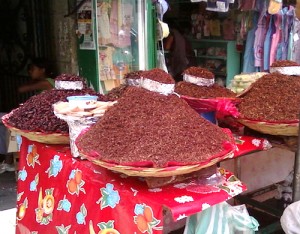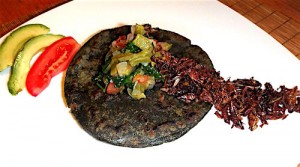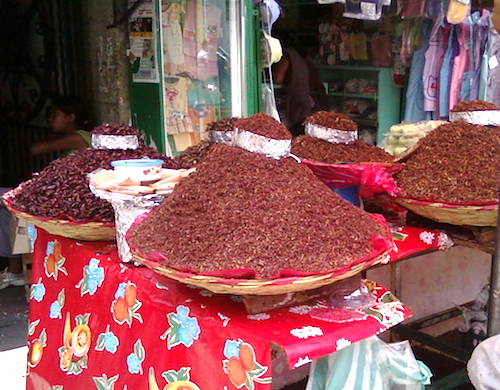
Chapulines in the Oaxaca Market
By José Marmolejo
Eating bugs is today considered acceptable–even cosmopolitan in Western civilizations. But before proceeding any further, shouldn’t ancient American civilizations be considered Western? Natives of both the North and South continents were eating bugs for millennia before the Spaniards discovered the New World. Well documented indeed are the innumerable ingredients and dishes of the Aztec emperors and the commoners. Notably the writings of Bernal Díaz del Castillo such as A True History of the Conquest of New Spain depict a diet beyond worth the wildest dreams of a gourmand.
Science has made us aware of all diseases a bug can carry and transmit. In Mexico however, the risk of getting sick eating insects is lower than eating seafood or chicken. Science has also showed us that the nutritional value of bugs is high and could solve world hunger. And one of the more important insects in the culinary is the chapulin—what Americans know as a grasshopper.
In Oaxaca, Mexico, chapulines are collected with nets early in the morning in the alfalfa fields. The small and tender ones can be eaten raw on the spot. Their flavor is complex but you guessed it right if you think they have more than a hint of alfalfa flavor. Aside from ethical and moral considerations, it is without a doubt a bit uncomfortable to hear the cracking and to feel their serrated legs move inside your mouth while you have breakfast in the field. If eating chapulines live and kicking is not your cup of tea, you can instead boil them, fry them, sauté them, bake them, or toast them on a griddle. They are very versatile. Once they are cooked, you will be consuming a dead grasshopper that is not going to bite or kick back. Aside from killing the bugs along with some bacteria, cooking them changes the texture and changes the flavor, and depending on the condiments used, their flavor is enhanced and this can turn it into a pleasant experience.
If raising or cooking chapulines does not appeal to you, they can be found already cooked in Mexican markets and in some baseball stadiums in the U.S.A. as snacks. They come in different sizes and with different condiments: fried in olive oil with garlic; just with salt; with chile powder and lemon; or au naturel. The large ones size can be added to an omelette; the small ones are best in rice or pasta at the end of the cooking, the ones salted with lime and pepper are the best companions of a double shot of Mescal (with beer recommended as a chaser), and my favorite presentation: the garlic and olive oil hoppers are added to a Guacamole Taco.
When eating roasted chapulines, a smoky and complex deep flavor comes assaults my senses. I can smell and taste the smoke of a wood fire and immediately get transported to Oaxaca–the place where I first tasted them many years ago.- but without delay, I come back to enjoy the here and now of their deep wonderful flavor. I would suggest that you bring home some from the ball game and carefully sauté them lightly in olive oil and garlic and let them cool off on a paper towel. Spread some guacamole on a warm tortilla or tostada and just sprinkle the chapulines over it. Have a cold beer on hand, close your eyes and transport yourself to Oaxaca for free. A shot or two of Tequila or Mezcal will do complete the job of the perfect snack. Buen provecho!
Note on the following recipe: Gorditas and Tlacoyos or Tortillas can be easily made by hand at home experimenting with corn flour, a tortilla press and a hot griddle on a cold or rainy Saturday afternoon. And thanks to Martha Margarita Baca for her assistance in prepping, photographing and consuming the dish, beer, and tequila used for this piece.
Gorditas with Nopales and Heavy on the Chapulines

A gordita (“little fat one”) is nothing but a fat corn tortilla, almost ½ inch thick. And given its thickness, it can be cut open and stuffed with beans, your favorite cheese, sauteed edible wild greens, mushrooms, and ground beef, among other things. Some Gorditas have their “stuffing” added while the dough is being kneaded, but the flavor is always good. Nopales are the pads of the Opuntia cactus that have been cooked and seasoned. In this case, we throw some nopales on top of the gordita and go heavy on the chapulines, as if the chapulines were moving to eat the nopales!
Ingredients
1 cup of cooked nopales
4 gorditas (if you can’t make or find gorditas use 8 regular corn tortillas. Two of them stuck together after a quick dip in hot oil for 5 seconds a side will substitute.
4 to 5 ounces of fried, roasted. or sauteed chapulines
2 serrano chiles, stems and seeds removed and minced
1/2 cup chopped onion
1 small tomato, finely chopped
1 clove garlic, minced
Salt to taste
Procedure
Wash and cut the cactus pads in julienne strips and boil until soft. Drain in a colander drain until cool. Rinse and drain again.
Sauté the cactus strips in olive oil with the serranos, onions, tomato and garlic. Add salt to taste.
Heat the gorditas on a griddle. Add the sautéed nopales on top of each gordita. Add the chapulines to each gordita. Roll everything up in the gordita and enjoy.
Yield: 4 servings
Heat Level: Medium
Latest posts by José C. Marmolejo (see all)
- Unconventional Seafood Salsas - 04/25/2022
- Cocineras Tradicionales: The Traditional Cooks of Mexico - 04/01/2022
- Carnitas Calientes - 03/11/2022








